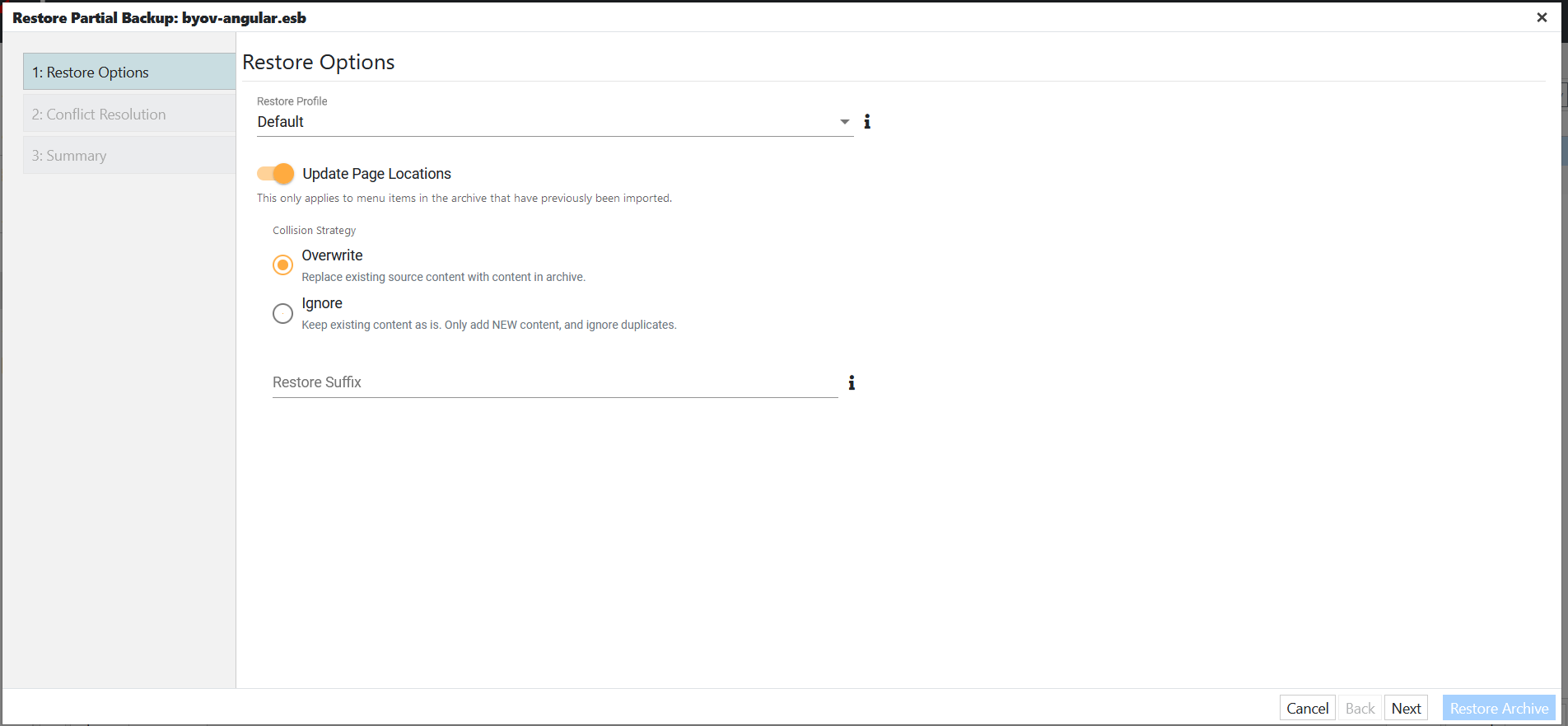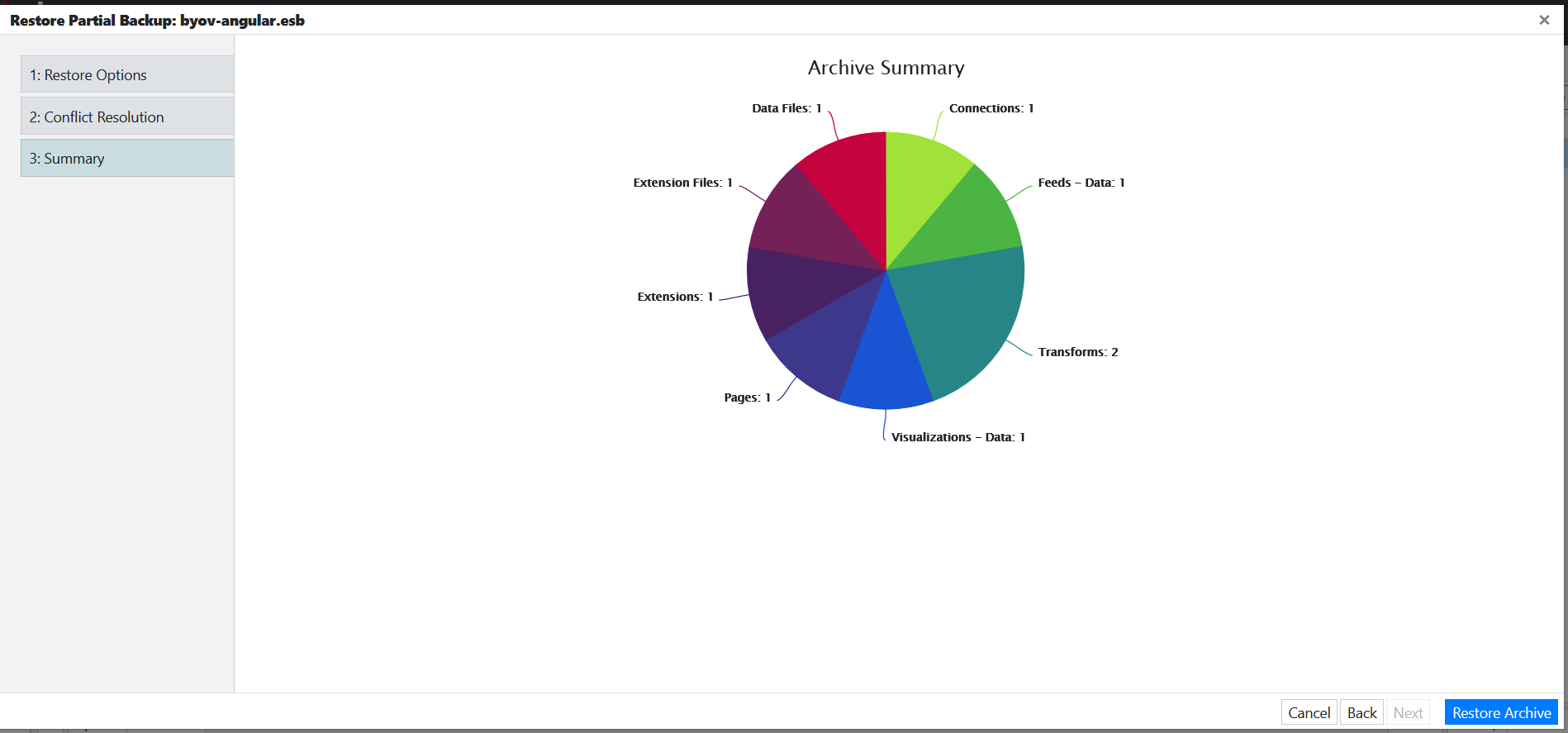A Partial Backup saves the relevant configuration for a set of pages. Partial Backups are typically used to migrate content from one system to another. When creating a Partial Backup, the server will discover all the requisite configuration needed to produce the Visualizations on the selected set of pages, and then package it up in an .ESB file. The .ESB file includes a variety of different objects:
- All Visualization instances on the page.
- All Actions associated with Visualization instances on the page.
- The Data Pipeline for all datasets being displayed on the page.
- All Node Variables used inside of Feeds and Transforms in the relevant Pipeline nodes.
- All Variable Constraints used to restrict input for Node Variables in the relevant Pipeline nodes.
- All rulesets used inside of a Visualization’s renderer.
- All Color Palettes and Icons used inside of rule sets.
Creating a Partial Backup
For instructions on creating a Partial Backup, refer to the Backup & Restore page.
Restoring a Partial Backup
Restoring a partial backup is a multi-step process.
Step 1: Restore Options

The options are as follows:
- Restore Profile
A restore profile saves the decisions made for each conflict in a partial backup. edgeCore will use those saved decisions as defaults for subsequent restore iterations, helping to streamline the restore process. - Update Page Locations
This option applies to menu items in the archive that have previously been imported. - Collision Strategy
Collision represents a pending change to something that already exists in the system. The collision strategy sets a default behavior for handling conflicts when processing a partial backup.
– Overwrite: This option will replace the existing content on the server with content in the backup.
– Ignore: This option will keep all existing content on the server as is. It will ignore any duplicates or changes, and only add NEW content that is in the backup. - Restore Suffix
This suffix is applied to the names of elements when a conflict is detected. It helps with the versioning of content when partial backups are iteratively applied.
Step 2: Conflict Resolution
If there are no conflicts with the content on the system, then the following message will be displayed: There were no collisions with existing content on the server.
If conflicts are detected, a list of conflicts will be displayed.
Conflict Strategy
When restoring a Partial Backup, the server can encounter conflicts. This typically happens when making changes to an existing archive, and then sharing those changes with someone else. When attempting to merge content into an existing system, the IDs of objects in the Partial Backup could conflict with IDs already in the target system. This typically indicates different “versions” of that element. edgeCore offers an itemized list of these conflicts and provides options for how to handle them.
- Overwrite – Keep what is in the backup. Overwrite what is currently on the server with content from the backup.
- Ignore – Keep what is on the server. Ignore what is in the backup.
Custom Icons and Partial Backups
In partial backups, only icons used in Visualizations are backed up. This means that only custom icons used on the selected page(s) are exported, along with the associated custom.csv file. A Partial Backup will include the entire custom.csv, which can contain references to icons that are not included on the selected pages in the partial backup. This means some icons might not be copied over, and this can result in broken images appearing in the icon chooser. The broken images in the icon chooser will not affect any of the Visualizations.
Step 3: Summary
The restore summary shows the end result of all the conflict resolution decisions that have been made in the wizard. This is a validation step that summarizes what will be brought into the system prior to performing a restore.
As a safety measure, the system will automatically perform a full backup prior to a restore. These automatic backups can be used to revert back to the system’s state prior to performing the restore. They are available through the Recovery tab in the Backup & Restore UI. See Backup and Restore for more information.

Step 4: Restore Archive
As a final step, click the Restore Archive button in the bottom right corner. A Restore in Progress pop-up is displayed. Once done, a confirmation message is displayed, and you will need to refresh the client.
Advanced Options: Restore Profile
Partial restore can be somewhat automatically controlled through the use of a Restore Profile.
A typical profile for the purpose of migrating development content to a production system might look like this:
{
"name" : "dev-to-prod",
"restoreType" : "ALL",
"collisionStrategy" : "OVERWRITE",
"useSrcPaths" : true,
"dropUnchangedEntities" : false,
"restoreRules" : [ {
"archiveMatchString" : "ConnectionDO",
"archiveMatchType" : "ENTITY_CLASS",
"matchAction" : "DROP",
"doClass" : "RestoreRuleDO"
} ],
"restoreSuffix" : "",
"entityActions" : [ ],
"doClass" : "RestoreProfileDO"
}
The profile above specifies that all Connections in the archive should be ignored in preference to those in the current (production) system. All other entities in the archive will be applied in the normal way (for example Feeds and Transforms, Visualization configuration, and Pages).
The restoreRules the field is a list of matching rules that allow you to specify what attribute to match against, a matching pattern, and then a default action to perform for configuration entities that match. The current attributes that can be matched against are:
ENTITY_CLASS– match against the Java class implementing the entity. Common classes include:- ConnectionDO – all connection types
- DataFeedDO – all feeds that are not Web Content feeds
- ProxyFeedDO – Web Content feeds
- TabularTransformDO
- RelationalTransformDO
- DataVisualizationDO
- SecurityParameterDO – Secured Variables and Credentials
ENTITY_TYPE– match against the entity’s type (for example"Web Content Connection"or"Web.*")ENTITY_NAME– match against the admin-specified name of the entity
When importing an entity from an archive, the restore rules are applied in the order they appear in the profile – the first one that matches is used. The matchAction provides a default action to perform for the entity. This can be overridden in the Restore Wizard in the Conflict Resolution step. Supported values for matchAction are:
DROP(ignore the entity from the archive)OVERWRITE(use the values of the entity from the archive to replace those of the corresponding existing entity in the system)
Every edgeCore instance has a Default restore profile, and new restore profiles can be found in [INSTALL_HOME]/exports/profiles/.
Permission to Create and Restore Partial Backups
edgeCore version: 4.3.6
As explained on the Overview page, in order for users to be able to create and restore partial backups, you need to assign security permissions to them.
Deleting Partial Backups
edgeCore version: 4.3.7
To learn how to delete partial backups and what permissions you need to assign to users, refer to the Overview page.